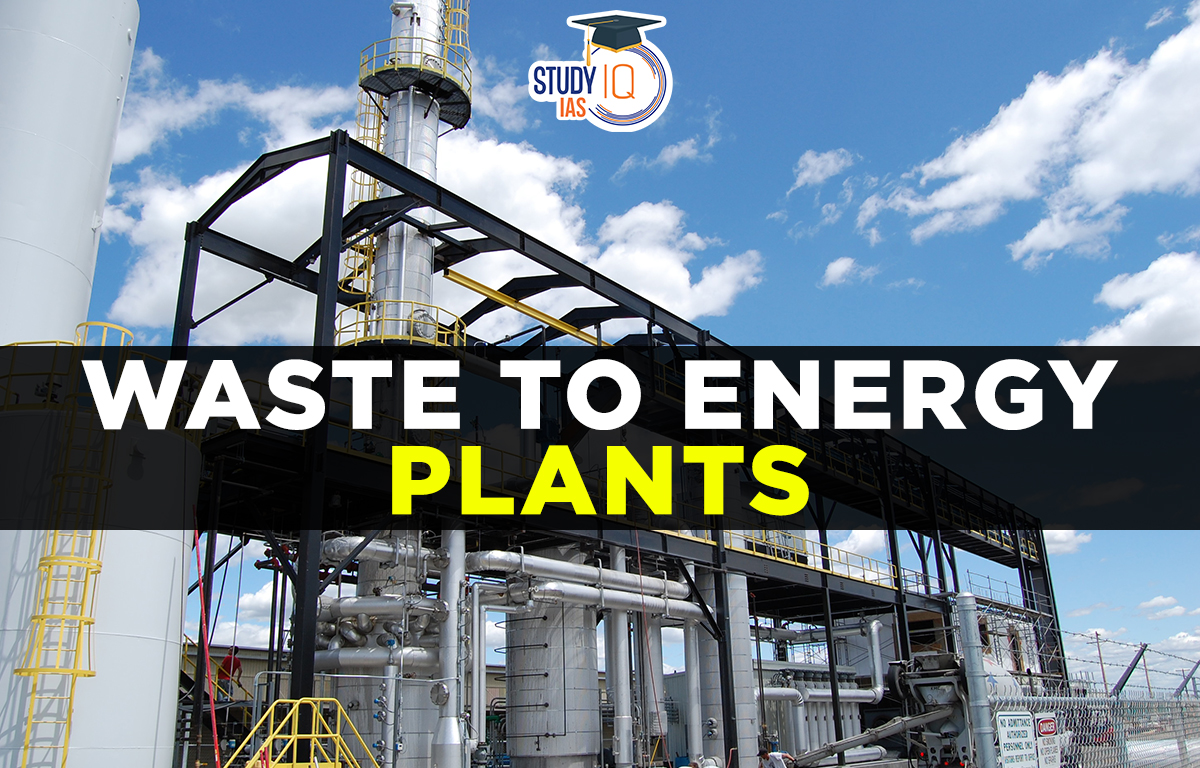Table of Contents
Context: The Government of Kerala recently announced the State’s first waste-to-energy project in Kozhikode.
What is Waste-to-Energy (WTE) Plant?
- Working: Waste-to-energy projects use non-recyclable dry waste to generate electricity.
- The energy plant works by burning waste at high temperatures and uses the heat to make steam. The steam then drives a turbine that creates electricity.
- Process: Solid waste in India is 55-60% biodegradable organic waste, which can be converted into organic compost or biogas.
- Of the non-biodegradable dry waste, only 2-3% – including hard plastics, metals, and e-waste – is recyclable.
- The remainder consists of low-grade plastic, rags, and cloth that can’t be recycled.
- Waste-to-energy plants use this portion to generate power.
- The waste is combusted to generate heat, which is converted into electricity.

What are Advantages of WTE Projects?
- Clean Energy: Energy generated from waste is clean and reliable, thus reducing the dependence on fossil fuels.
- Safe Waste Disposal: WTE facilities provide a safe, technologically advanced means of waste disposal that reduces greenhouse gases, generates clean energy and recycles metal.
- Mitigate Climate Change: Waste-to-Energy is widely recognized as a technology that can help mitigate climate change.
- Recycles Metal: The technology used to convert waste into energy also recycles any metal that remains after combustion, including steel and aluminum, further shrinking the amount of unusable waste.
- Reduces SWM Burden: Waste-to-Energy process increases the State’s power generation capacity and eases the solid waste management (SWM) burden.
- Profitable Business: If the right technology is employed with optimal processes and all components of waste are used to derive value, waste-to-energy could be a profitable business in the renewable energy sector.
- Opportunity for Indian Companies: With waste management and waste-to-energy becoming important priorities, opportunities exist for companies to provide support services like turnkey solutions.
- Turnkey solutions are ready-to-go solutions that are easily deployed in a business.
Waste-to-Energy (WTE) Technologies
- Incineration: It is complete combustion of Municipal Solid Waste with the recovery of heat to produce steam that in turn produces power through steam turbines.
- Gasification: It is a process that uses high temperatures in the presence of limited amounts of oxygen to decompose materials to produce synthetic gas (a mixture of carbon monoxide (CO) and hydrogen (H2)).
- This gas further can be used for thermal or power generation purposes.
- Pyrolysis: It uses heat to break down combustible materials in the absence of oxygen, producing a mixture of combustible gases (methane, hydrogen, and carbon monoxide), liquids and solid residues.
- The gas can be used in boilers to provide heat, or it can be cleaned up and used in combustion turbine generators.
- Biomethanation: It is anaerobic digestion of organic materials which is converted into biogas.
- Anaerobic digestion (AD) is a bacterial fermentation process that operates without free oxygen and results in a biogas containing mostly methane, carbon dioxide and other gases.
What are Challenges in WTE Projects in India?
- Sustainability: Solid waste in India has low calorific value (water waste) due to improper segregation and dumping of mixed waste.
- Biodegradable waste which has high moisture content and cannot be used for power generation.
- High Cost: WTE projects have high costs of energy production. While State electricity boards are considering purchasing power from newer renewable energy sources like waste-to-energy, the price of the power generated needs to halve.
- Feasibility: Some activists argue that WTE plants do not get many buyers for the power they generate due to cheaper alternatives being available. Also, the maintenance costs of WTE projects are high.
- Mismanagement: Many waste-to-energy projects in India have failed because of improper assessments, high expectations, improper characterization studies, and other on-ground conditions.
- Limited to Dry Waste: The quantity of waste generated by cities varies due to multiple factors, including season, rainfall, and the floating population.
- Waste-to-energy projects can consume only non-recyclable dry waste, which is about 25% of the waste.
- Environmental Pollution: As WTE plants have to handle a vast quantity of mixed waste, the housekeeping is extremely challenging leading to a lot of dour and visual pollution.
Way Forward
- Setting up waste-to-energy projects is complex and needs the full support of the municipality, the State and the people.
- To overcome its various challenges, the municipality must ensure that only non-biodegradable dry waste is sent to the plant and separately manage the other kinds of waste.


 Mukhyamantri Majhi Ladki Bahin Yojana, O...
Mukhyamantri Majhi Ladki Bahin Yojana, O...
 Nipah Virus (NiV): Structure, Testing Me...
Nipah Virus (NiV): Structure, Testing Me...
 Elon Musk’s America Party: A New Chapt...
Elon Musk’s America Party: A New Chapt...





















